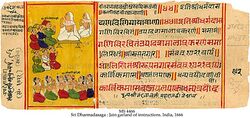Social:Old Gujarati
| Old Gujarati | |
|---|---|
| Era | Developed into Middle Gujarati by the 16th century and the Rajasthani languages |
Indo-European
| |
Early forms | Vedic Sanskrit
|
| Devanagari | |
| Language codes | |
| ISO 639-3 | – |
| Glottolog | None |

The text is a Prakrit didactic work of how best to live a proper Jain life, aimed probably at the laity. The Svetambara pontiff, Sri Dharmadasagaî, lived in the mid-6th century. The Old Gujarati prose commentary was written in 1487. The colophon gives the place, date, and the name of the religious leader, Sri Nandalalaji, on whose order the work was transcribed.
Old Gujarātī (જૂની ગુજરાતી; 1200 CE–1500 CE), the ancestor of modern Gujarati and Rajasthani,[2] was spoken by the Gurjars, who were residing and ruling in Gujarat, Punjab, Rajputana and central India.[3][4] The language was used as a literary language as early as the 12th century. Texts of this era display characteristic Gujarati features such as direct/oblique noun forms, postpositions, and auxiliary verbs.[5] It had three genders, as Gujarati does today, and by around the time of 1300 CE, a fairly standardized form of this language emerged. While generally known as Old Gujarati, some scholars prefer the name of Old Western Rajasthani, based on the argument that Gujarati and Rajasthani were not yet distinct. Factoring into this preference was the belief that modern Rajasthani sporadically expressed a neuter gender, based on the incorrect conclusion that the [ũ] that came to be pronounced in some areas for masculine [o] after a nasal consonant was analogous to Gujarati's neuter [ũ].[6] A formal grammar, Prakrita Vyakarana, of the precursor to this language, Gurjar Apabhraṃśa, was written by Jain monk and eminent scholar Acharya Hemachandra Suri in the reign of Chaulukya king Jayasimha Siddharaja of Anhilwara (Patan).[7]
Literature
Major works were written in various genres, for the most part in verse form, such as:[8]
- rāsa, predominantly didactic narrative, of which the earliest known is Śālibhadrasūri's Bhārateśvarabāhubali (1185).
- phāgu, in which springtime is celebrated, of which the earliest is Jinapadmasūri's Sirithūlibadda (c. 1335). The most famous is the Vasantavilāsa, of unknown authorship, which is undeterminedly dated to somewhere in 14th or 15th century, or possibly earlier.
- bārmāsī, describing natural beauty during each of the twelve months.
- ākhyāna, in which sections are each in a single metre.
Narsinh Mehta (c. 1414–1480) is traditionally viewed as the father of modern Gujarati poetry. By virtue of its early age and good editing, an important prose work is the 14th-century commentary of Taruṇaprabha, the Ṣaḍāvaśyakabālabodhavr̥tti.[8]
Phonology
The retroflex lateral flap (ḷ) is generally absent, which is however rather common in Modern Gujarati. This may indicate that it was a later re-introduction, perhaps under the influence of Marathi with the Maratha rule.
References
- ↑ Ernst Kausen, 2006. Die Klassifikation der indogermanischen Sprachen (Microsoft Word, 133 KB)
- ↑ Dalby 1998, p. 237
- ↑ Ajay Mitra Shastri; R. K. Sharma; Devendra Handa (2005), Revealing India's past: recent trends in art and archaeology, Aryan Books International, p. 227, ISBN 8173052875, "It is an established fact that during 10th-11th century ... Interestingly the language was known as the Gujjar Bhakha."
- ↑ K. Ayyappapanicker (1997), Medieval Indian literature: an anthology, Volume 3, Sahitya Akademi, p. 91, ISBN 9788126003655, https://books.google.com/books?id=KYLpvaKJIMEC&pg=PA91
- ↑ Mistry 2003, p. 115
- ↑ Smith, J.D. (2001) "Rajasthani." Facts about the world's languages: An encyclopedia of the world's major languages, past and present. Ed. Jane Garry, and Carl Rubino: New England Publishing Associates. pp. 591-593.
- ↑ Rita Kothari (8 April 2014). Translating India. Routledge. pp. 73–74. ISBN 978-1-317-64216-9. https://books.google.com/books?id=2-xQAwAAQBAJ&pg=PA73. Retrieved 5 August 2014.
- ↑ 8.0 8.1 Cardona & Suthar 2003, p. 661
Further reading
- Bender, E. (1992) The Salibhadra-Dhanna-Carita: A Work in Old Gujarati Critically Edited and Translated, with a Grammatical Analysis and Glossary. American Oriental Society: New Haven, Conn. ISBN:0-940490-73-0
- Brown, W.N. (1938), "An Old Gujarati Text of the Kalaka Story", Journal of the American Oriental Society 58 (1): 5–29, doi:10.2307/594192.
- Dave, T.N. (1935) A Study of the Gujarati Language in the XVth Century. The Royal Asiatic Society. ISBN:0-947593-30-6
- Tessitori, L.P. (1914–1916) "Notes on the Grammar of Old Western Rajasthani." Indian Antiquary. 43–45.
- Cardona, George and Suthar, Babu. 2003. Gujarati. In Cardona, George and Jain, Dhanesh (eds.), The Indo-Aryan Languages, 659-697. London: Routledge.

